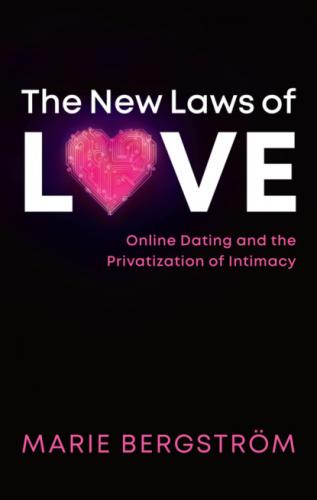1.1. Front page of The Matrimonial News and Special Advertiser (February 1877)
1.2. Newspaper publicity for the “computer dating” agency Compatibility (LIFE, August 1969)
1.3. Interface of the BBS Matchmaker
1.4. Interface of the Minitel messaging system ULLA
1.5. Interface of Match.com (year 2000)
1.6. Interface of Tinder (year 2012)
2.1. Homogeneity in dating app interfaces: from left to right, Tinder, Bumble, Hinge, happn, and Facebook Dating
2.2. Stereotypical branding between love and sex (Match and EasyFlirt)
3.1. Rate of use of online dating platforms in France, the United States, and Germany (%)
3.2. Ranking of meeting venues in the United States in 2019 and in Germany in 2020 (%)
4.1. Time between initial contact and first sexual intercourse among couples in France (%)
6.1. Percentage, by age group, of the women and men in the United States who have used a dating site or app at least once
6.2. Pyramid of ages, by gender, declared on four European dating platforms (%)
7.1. Share of female and male users initiating contact on dating platforms in six countries in 2019 (%)
Sources
Surveys
| ATP | The American Trends Panel wave 56, Pew Research Center, Washington, DC, 2019 (4,860 respondents). For more information, see Pew Research Center, 2020a, 2020b, 2020c. |
| Baromètre 2016 | Baromètre Santé 2016, Santé publique France, 2016 (15,216 respondents). For more information, see Bajos et al., 2018. |
| CSF | Contexte de la sexualité en France, INSERM–INED, 2006 (12,364 respondents). For more information, see Bajos and Bozon, 2012. |
| EPIC | Étude des parcours individuels et conjugaux, INED–INSEE, 2013–2014 (7,825 respondents). For more information, see Rault and Régnier-Loilier, 2019. |
| Eurostat | Eurostat database, 2002–2019, European Union. For more information, see Eurostat, 2020. |
| GSS | General Social Survey, NORC–University of Chicago–National Science Foundation, 1972–2018 (64,814 respondents). For more information, see Marsden, 2012. |
| IALP | Internet & American Life Project Survey, Pew Research Center, Washington, DC, 2013 (2,252 respondents). For more information, see Smith and Duggan, 2013. |
| Pairfam | The German Family Panel release 12.0, German Research Foundation (DFG), 2019–2020 (7,630 respondents). For more information, see Huinink et al., 2011; Brüderl et al., 2021. |
| PTS | Pew Tracking Survey, Pew Research Center, Washington, DC, 2015 (2,001 respondents). For more information, see Pew Research Center, 2016. |
Big Data
Meetic Group Platforms, Meetic Group Europe, 2019:
Platforms analyzed: Match, Meetic, Ourtime, DatingDirect, Lexa, LoveScout24 and Neu.
Metadata on: anonymized user profiles (27,709,707 profiles) and contact behavior (824,989,940 exchanged messages).
Interviews
Interviews with users, 2007–2018:
biographical interviews with 82 French users of dating sites and applications, conducted by Marie Bergström and Rébecca Lévy-Guillain.
Interviews with entrepreneurs, 2009–2019:
semi-structured interviews with 19 French, US, and Canadian founders or employees of dating sites and applications, conducted by Marie Bergström.
Introduction
Match, Meetic, OkCupid, Grindr, LoveScout, Tinder, Happn, Bumble… These are just a few of the thousands of dating platforms available online today. The first website to specialize in matchmaking appeared in the United States in the mid-1990s and was soon to be imitated. As the internet expanded internationally, competing sites rolled out at a quick pace across North America and Europe. They were joined some twenty years later by mobile phone applications that immediately became immensely popular, especially among the young. In the past two decades, these platforms have remapped the landscape of dating across much of the western world and beyond, changing the way people meet partners, but also challenging our ideas about sex and love.
The change is remarkable. Since at least the nineteenth century, personal ads, marriage brokers, and other “lonely hearts” networks have offered their services to bring single people together and match prospective partners. Today’s dating sites and apps are the direct descendants of those earlier forms of mediated dating; in fact they have inherited many features from their ancestors. What is fundamentally new, however, is their popularity. Until the advent of the internet, the use of commercial matchmaking remained a marginal and marginalized practice. In the 1980s and 1990s, surveys carried out in the United States and in France showed that approximately fewer than 1 in 100 people had met their spouse through a matrimonial ad or agency, for example (Bozon and Heran, 1989; Laumann et al., 1994). In the ranks of the heterosexual population, to resort to such services was taboo; the companies were generally distrusted and users consisted predominantly of divorced and widowed individuals. Mediated dating was considered something of an outcast behavior in the world of dating.
Digital platforms have brought about a major shift. Dating sites and apps have become a common way of meeting partners, and this behavior has lost most of its former social stigma. Users come from all social milieus and background and, unlike older forms of matchmaking, these new ones appeal primarily to young people. The most recent survey carried out in the United States – the birthland of online dating – showed that 30% of American adults had already used a dating site or app in 2019. Among 18- to 29-year-olds, the percentage rose to 48% (Pew Research Center, 2020c). As online dating became commonplace, commercial matchmaking finally emerged from the shade, to reach a broad general public.
What made this change possible? How do we explain this unprecedented success of online dating, and what are the implications? To answer these questions is to draw a portrait of modern love and contemporary sexuality. This is the aim of the present book. By looking at dating and how it changes online, this book tells a new story of the transformation of intimacy, a story that differs considerably from what is currently said about this phenomenon.
Dominant discourses on online dating
The spread
